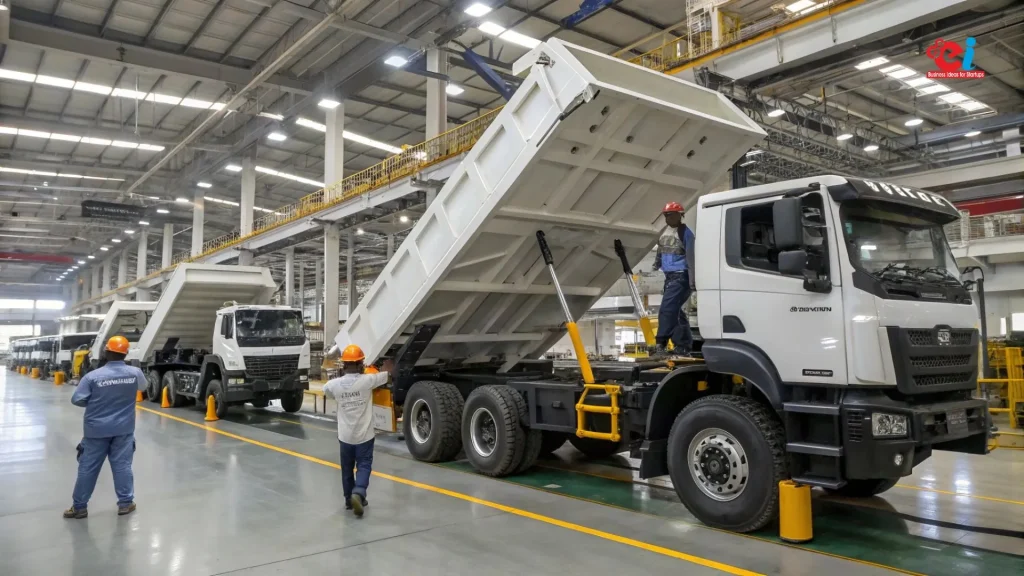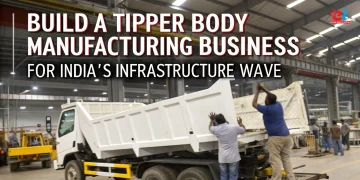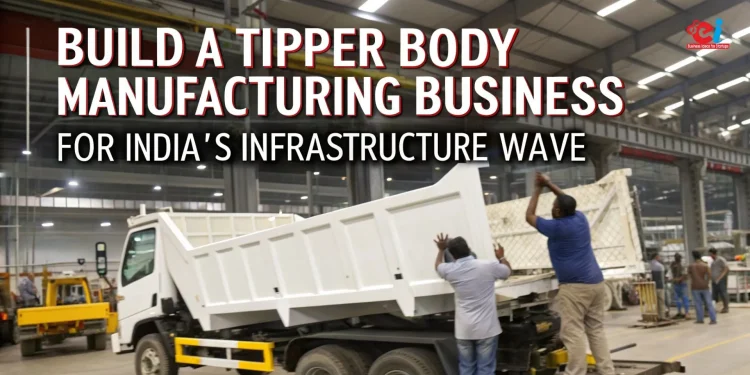The burgeoning increase in the value chains of India and other countries, including infrastructure development and mining activities, waste management as well as logistics, has increased the need for customized body heavy commercial vehicles. Among all vehicles, Dump trucks or tipper trucks are exceptionally useful in transporting bulk quantity of materials such as sand, gravel, stones, construction debris, ores, and other industrial raw materials. The rising scale and frequency of infrastructure projects has created a market for tipper body fabrication which is growing into a profitable venture for newcomers in industrial manufacturing or auto component industry.
Tipper body is not a factory fitted standard component instead, it is an expertly designed and fabricated steel structure made specific to the commercial vehicle chassis that requires a tipper body. Major chassis OEMs like Tata, Ashok Leyland, BharatBenz and Mahindra sell their products as base frames and specialize fabrication shops complete the body- specifically for tipper trucks.
This creates opportunities for thousands of ancillary fabrication units across the nations for individuals and major players in the infracrcture sector. With precise planning, appropriate machinery, skilled manpower, industrys’ proprietary knowledge, and investment in marketing enable one to start a tipper body fabrication business and provides great margins and growth.
Market Overview and Business Potential
The current state of India’s infrastructure-heavy economy, with initiatives like PM Gati Shakti, Bharatmala, Smart Cities Mission, and mining expansion policies, has further increased the demand for heavy-duty vehicles. Tipper trucks are indispensable for functions like earthmoving and the transport of construction and building materials. Furthermore, urban municipal corporations are adopting the use of tippers for waste and debris removal. All these factors create a constant need and market for fabricated tipper bodies of different sizes and specifications.
The fabricated tipper body market caters to many end-users including mining companies, hired contractors, municipal corporations, cement industries, builders, and transporters. With Indian commercial vehicles growing in numbers, the secondary market and refurbishment market for tipper bodies is also increasing. The export market appears to have good opportunities especially with the African and Middle Eastern countries who regard Indian tipper bodies for their generous pricing and toughness.
There is a lot of work available for a well-established unit to supply fleet operators, dealerships, government, and even other OEMs that outsource bodywork to the business. The business model is also expandable as primary production diversifies into other areas such as tanker fabrication, container and refrigerated truck bodies.
Related: Truck Body Building Industry
Determining the Best Site and Facilities
The location picked should correspond with automobile tipper body fabrication business, as it is a primary determinant of success in this kind of enterprise. Because the company involves dealing with considerable truck chassis, steel sheets, and bulk machinery, an industrial plot is required. Ideally, the unit ought to be positioned within an automobile industrial cluster or close to a transport hub where larger vehicles access the premises. Being close to the markets of steel, industrial zones and automobile dealers provides a logistical edge by minimizing lead time.
For a mid-sized fabrication unit, 15,000 to 30,000 sq. ft. of open and covered space is needed to take care of fabrication bays, welding stations, painting booths, storage yards for raw materials, and truck parking lots. The layout must incorporate provisions for lifting devices such as EOT cranes, chain pulleys, or hydraulic lifts for mounting and dismounting vehicles to enable efficient loading and unloading.
In addition, areas for administrative offices, design studios (CAD/CAM), QC labs, and utility rooms (compressors, gas cylinders, water lines) are to be constructed. A covered painting and dry booth is required to meet safety and environmental policies. Proper drainage, ventilation exhausts, welding fume extraction systems, fire safety equipment, and other necessary apparatus must be added to comply with the Factory Act, Pollution Control Board regulations, as well as other regulations.
Machinery and Tools Required for Fabrication
Fabrication of the tipper body includes the processes of cutting, bending, welding, assembly, and painting of steel components. A broad range of fabrication machinery is needed to achieve precision, productivity, and quality in the processes, especially with a semi-automatic or fully automatic line. The primary equipment are:
- Hydraulic shearing machines for MS and HR sheet cutting to size.
- Hydraulic press brakes for bending steel sidewalls, floors, and structural profiles.
- CNC or oxy-fuel plasma cutting machines for the custom profile high-precision cut.
- Welding machines with MIG/TIG/ARC options for steel parts of different thicknesses.
- Radial drilling machines for bracket and base plate hole making.
- Surface grinding machines and angle grinders for the completion of welded joints.
- Shot blasting machines for surface cleaning prior to painting.
- Dust free and air compressor equipped spray painting booths with volumetric and curing systems.
Welding torches, angle cutters, hand tools, jigs, and other fixed machinery tools complements the empowering guiding equipments. Equipment like trolleys, forklifts, and jib cranes are considered vital contributing towards the working efficiency as well as safety of a shop floor. When cutting or welding on high volume orders meant for fleet buyers, productivity and uniformity is best achieved through automation.
Raw Materials and Sub Assembly Materials Procurement
Mild steel is mostly used in tipper body manufacturing, and is available in varieties such as HR sheets, square tubes, C-channels, and angle sections. The material’s thickness choice either 2 mm, 6 mm or more, depends on the tipper’s payload and application. Thinner gauge sheets are preferred by light duty tippers used in municipal transport, while mining tippers come requipping them with thicker relefasters and higher tensile strength.
Crafting parts in house or procuring them from vetted specialized vendors is applicable to other key components such as hydraulic cylinders, hinges, latches, tipping mechanisms, reinforcement ribs, tool boxes, tail gates, lighting systems, and ladder platforms. Builders and installers of the equipment often partnered with reputable suppliers, especially when it comes to the hydraulic topping kit supplied for body lift on material discharge.
Stocking consumable items such as welding rods, cutting gas, paint, primer, abrasive pads, and screws need to be done in bulk. Long-term vendor relationships leads to improved pricing, quality, and faster procurement cycles. Recycling and scrap recovery also help in controlling costs and meeting environmental regulations.
Related: Manufacturing of Truck Mud Flaps
Safety Regulations, Licensing, and Compliance Guidelines

The fabrication unit has to be registered under MSME Act or Udyam Registration to avail of tax benefits and subsidies before starting operations, therefore, must be registered. State Pollution Control Board, Factory Inspectorate, and local municipal offices also have to clear the business. Factory laws also ensure non-negotiable provisions of safety certifications, fire safety compliance, and labor welfare.
Integrating regulations of motor vehicles with the tipper body business is crucial. If the body needs to be permanently mounted and registered, it will need to follow the Automotive Industry Standard (AIS) 093 which focuses on the type approval of vehicle bodies in India. Compliance with CMVR (Central Motor Vehicle Rules) may be required along with passing fitment inspections by Regional Transport Offices (RTOs).
ISO certification, specifically ISO 9001 for quality management, improves the business’s reputation among OEMs and institutional buyers. An SOP (Standard Operating Procedure) for design, welding, inspection, and testing increases value during audits and client reviews if it is documented properly.
Workforce Strategy and Skilled Labor
A skilled workforce is paramount to the success of a fabrication shop. Welders, fabricators, sheet metal workers, hydraulic technicians, and painters need to have experience with automotive body structures. A medium-scale unit typically employs 20 to 30 staff in production, maintenance, stores, and quality control.
Body layouts, structural load diagrams, and detailed fabrication drawings need CAD designers and mechanical engineers. 2D and 3D design software is now used by modern units for faster editing and precision. Operational and material cost savings result from having trained CNC operators, plasma cutters, and industrial painters.
Compliance with labor regulations and creation of a positive work atmosphere is achieved by having in-house training sessions, safety drills, and regular health checks. Focus on operations and client relations improves when security, housekeeping, and logistics are outsourced as they are non-core functions.
Financial Planning and Investment Requirements
Capital Investment
The scale of automation greatly impacts the capital investment needed for the construction of a tipper body fabrication unit. A small-scale unit servicing 8–10 tippers per month requires an investment of about ₹1.5 to ₹2 crores. On the other hand, a medium-sized unit with automated machinery and a full hydraulic setup has a monthly capacity of 30–40 tippers and would need ₹4–7 crores. This estimate covers the cost of land, building, machinery, working capital, registration, and even contingency reserves.
Operating Expenses and Revenue
Operating expenses consist of payment of salaries, consumables, electricity and other fuels, insurance, general maintenance, transport, and other relevant costs. The unit earns revenue from charging a fabrication cost per body that ranges from ₹1 lakh to ₹3 lakh depending on the size, design, and material grade used. Premium pricing is set for special finishes, customizations, and expedited delivery.
Break-even and Financial Support
The business is expected to break even in 2–3 years owing to healthy profit margins of around 18%–30% and limited competition in Tier 2 and Tier 3 cities. There are several MSME schemes available through banks and NBFCs providing term loans, working capital limits, and machinery loans. Detailed DPR documentation assisting multi-stage financing is critical to optimizing the said finance.
Marketing and Business Development Plan
Client Acquisition and Relationship Building
Marketing in the tipper body industry is very much based on relationships. The partnership with Tata, Ashok Leyland, and BharatBenz vehicle dealerships provides direct access to clients who buy chassis. Among other purchasers are builders, contractors, mining operators, and government departments. Selling in the government e-marketplace (GeM), participation in infrastructure expos, and roadshows improves marketing reach and lead collection.
Digital Marketing and After-Sales Service
Digital marketing is becoming increasingly important too. The company can easily attract clients by having a well-optimized website, showcasing completed works, and offering virtual design previews. Other services such as body repair, repainting, hydraulic maintenance, and after-sales services create continuous income and customer satisfaction.
Expansion Opportunities
After a certain age, the business can expand into other areas like manufacturing trailer bodies, fabricating tankers, or producing container chassis to achieve vertical integration and diversification of income streams. There is also great potential for profits in exporting fabricated kits to Africa and Southeast Asia where countries have active road construction projects.
Function of NPCS in Project Implementation
As with any new business stream, a novice entrepreneur venturing into the tipper body fabrication business would need expert help to guide them through the execution process which in turn would ease headaches and other issues pertaining to risks. NIIR Project Consultancy Services (NPCS) claims to provide one-stop solutions for business strategy, marketing study, project feasibility, layout work, machinery procurement, compliance, and financial modelling. Their project reports and technical consultancy transform the business idea into fundable and growth-ready enterprises.
NPCS assists entrepreneurs with guidance from the conceptual stage ensuring the venture is in compliance with government regulations, best industry practices, and international benchmarks in quality and operation efficiency to ensure profitability right from the onset.
Final Words
The tipper body fabrication industry is an emerging new sector of India’s infrastructure and automotive industry. It has strong demand from the mining, construction, public works departments as well as growth in commercial vehicle sales which makes this region almost stable but expanding. Even though the industry requires physical infrastructure and heavy machinery combined with skilled labor, its ease of scaling, profitability, and operation resilience makes this a must-try for budding industrial entrepreneurs.
Aspiring business owners can achieve success and have a positive impact on the nation’s development by utilizing professional consulting services like NPCS for developing strong client relationships while implementing design protocols and technical guidelines, setting up a detailed fabrication workshop, and ensuring plant maintenance in the workshop.


























